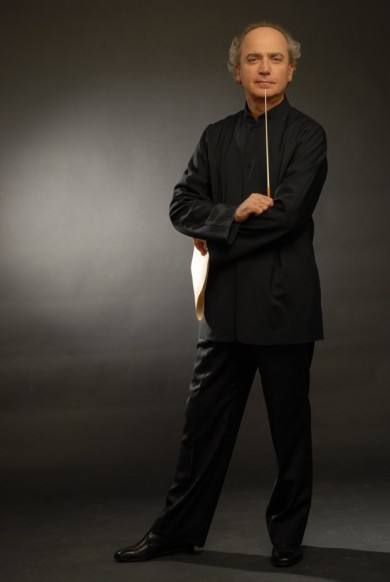Miami Symphony opens with colorful showpieces and a world premiere

Eduardo Marturet conducted the season-opening concert of the Miami Symphony Orchestra Sunday night at the Arsht Center.
Two orchestral showpieces and the premiere of a piano concerto in the romantic style comprised the season-opening program of the Miami Symphony Orchestra Sunday night at the Arsht Center.
Music director Eduardo Marturet told the large and highly enthusiastic audience that this season marks his eleventh year with the ensemble and the concert impressively demonstrated his skill as an orchestra builder. Gone are the days when this orchestra sounded scrawny and undernourished and section leaders were tentative or inadequate. Throughout the evening, the performances were consistently well played, smoothly coordinated and thoroughly professional. Marturet’s considerable interpretive gifts were also on display.
Ravel’s Bolero and Rimsky-Korsakov’s Scheherazade, the evening’s two orchestral blockbusters, both thrive on thematic repetition. In the thrice-familiar Ravel work, one rhythmic motif is repeated constantly by different instruments or sections. The challenge for the conductor is to keep the piece from turning to monotony.
Marturet did not fall into that trap. He kept the ensemble taut and built the huge orchestral salvo of a climax organically. From the first tonally exquisite flute to the clarinet, bassoon and wailing trombone, instrumental solos were expertly articulated. Marturet also brought out the consequential harp part, which often gets buried under the orchestral sonorities.
In Rimsky-Korsakov’s Arabian Nights-inspired symphonic suite, the repeated melodic material requires imaginative variation in the shaping and molding of phrase and line to make its full colorful effect. Marturet did not allow “The Sea and Sinbad’s Ship,” the score’s opening movement, to plod and he emphasized the glints of orchestral color that dot the work. Concertmaster Daniel Andai’s narrative interjections were richly intoned and the warmth and flexibility of Grace Ho’s cello solos were standouts.
Marturet took a fast, fluid tempo for “The Young Prince and The Young Princess” while drawing sensuous and sonorous playing from the strings. The wind-percussion episode was agile and crisp with plenty of snap. In the final movement, Andai played his solos with riveting intensity and Marturet gave the “Festival at Bagdad” music an appropriately wild and acerbic twist. Brass playing in the shipwreck sequence was solid and firm, avoiding raucousness. The coda was taken at a measured pace with Kristina Finch’s harp coming through beautifully over the final violin lines.
The decision to add a narration between movements was more questionable. Athina Klioumi, Marturet’s wife and a glamorous actress and model, was herself bedecked with jewels as the voice of Scheherazade, telling her tales to the Sultan to save her life. She was a compelling narrator, bringing out the drama of the stories. While this presentation made for entertaining theater, Rimsky-Korsakov’s music evocatively pictures the stories by itself and the spoken part interrupted the flow of the music. A more effective bit of theatricality was the dimming of the lights on stage during the score’s final pages with only a spotlight on Andai and Marturet.
Between the familiar fare, Florencia Di Concilio’s Piano Concerto No. 2 received its world premiere. Commissioned by the Miami Symphony, the Uraguayan-Italian composer’s score might be called “Rachmaninoff’s Piano Concerto No. 5.” Starting with the opening surging theme for the piano and strings, Di Concilio’s work is unabashedly romantic. The concerto is deftly constructed with imaginative touches, including a lengthy first movement cadenza that is actually a set of variations on the main melody. Di Concilio is a highly experienced film composer and that was obvious in the second movement Adagio with its “evoke the moonlight” principal theme. The Allegro finale stems from a single, vaguely Russian sounding subject.
While many compositions teachers may wince at the concerto’s unapologetic retro style, Di Concilio knows how to write and develop good melodic material and her score is a real crowd pleaser. At a compact twenty minutes, the work does not wear out its welcome. With its pianistic flair and vivid orchestral writing, Di Concilio has constructed an appealing essay.
The concerto is a solo showpiece of the old fashioned variety and Ciro Fodere was on top of its keyboard gymnastics all the way. Since his years as a New World Symphony fellow, Fodere has been an impressive solo and chamber player. His light touch and affinity for sweeping lines was perfect for Di Concilio’s score and he had the whipcrack speed and digital dexterity to tear through the concluding movement at full power. Andai’s singing tone in the recurrent violin solos and the sheen and depth of the string section under Marturet’s knowing direction made a strong case for Di Concilio’s work.
The Miami Symphony Orchestra season continues with Marturet’s Pictures for an Exhibition and Lefrak’s Variations on a Work by Sandra Muss 6 p.m. November 20 at the Arsht Center in Miami. themiso.org 305-275-5666
Posted in Performances
2 Responses to “Miami Symphony opens with colorful showpieces and a world premiere”
Leave a Comment
Mon Oct 24, 2016
at 12:23 pm
2 Comments
Posted Oct 25, 2016 at 9:56 am by Erin Paul
While the players deserve accolades for their music making, the management of this orchestra deserves nothing of the sort. This organization owes local players payment for concerts dating back to the 2012-2013 season. It’s absolutely unbelievable that they continue to book expensive soloists in expensive halls and can’t be bothered to pay the players in the local area that performed for them 4 years ago. The South Florida symphony management cleaned up their act, now it’s time for MISO to do the same.
Posted Oct 27, 2016 at 9:41 am by Max Mayfield
I thoroughly enjoyed this season’s opening performance of the Miami Symphony Orchestra.
Ravel’s Bolero and Rimsky-Korsakov’s Scheherazade were my favorites. The musician who played the snare drum throughout Bolero is to be commended. S FL is blessed to have the MISO and the Arsht Center.